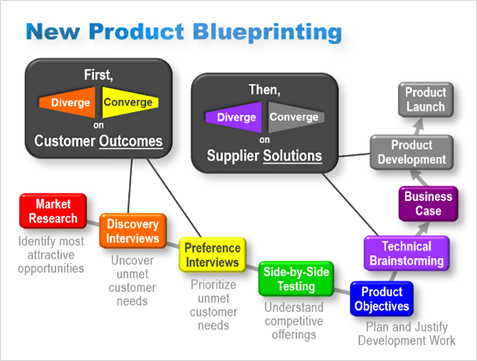New Product Blueprinting and design thinking have four things in common.
Let’s examine the common ground shared by Design Thinking and New Product Blueprinting… before exploring their differences in the next article.
- Begin with the end: New Product Blueprinting and Design Thinking both “begin with the end in mind” (Stephen Covey). Design thinkers sometimes use the term “wicked problem” to describe situations where both the problem and solution are initially unknown. In Blueprinting, users first seek to fully understand customers’ desired future state by exploring dozens of customer outcomes.
- Ambiguity is good: Design thinking can sometimes feel “fuzzy” to those comfortable with more analytical methods common in science and engineering. But it is precisely this willingness to examine many possibilities—and to iterate—that gives the methodology its power. In Blueprinting, users are encouraged to suspend work on “the answer” (their solutions) until they understand “the question” (customer needs).
- Customer immersion: Design thinking encourages designers to fully understand the customer’s world, using interviews, observation, etc. In Blueprinting, the mantra, “You don’t know what you don’t know” reinforces the need to let the customer lead the supplier to whatever they think is important. Blueprinting’s AMUSE customer tour methodology is the B2B analogue to Design Thinking’s ethnographic research.
- Diverge and Converge: Both Design Thinking and Blueprinting rely heavily on divergent thinking (creating choices) and convergent thinking (making choices). In fact, Blueprinting does this twice: first around customer outcomes, and then around supplier solutions (see diagram). Compared to most Design Thinking, Blueprinting is more rigorous in the former (using Discovery and Preference interviews).

Keywords: design thinking, New Product Blueprinting, diverge, converge, wicked problem, customer needs, customer immersion, customer insight
